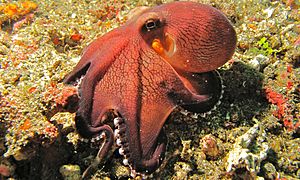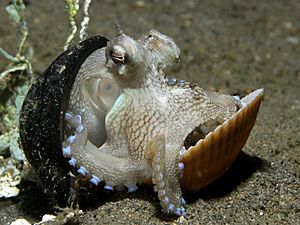Coconut octopus facts for kids
Quick facts for kids Coconut octopus |
|
|---|---|
 |
|
| Conservation status | |
| Scientific classification | |
| Genus: |
Amphioctopus
|
| Species: |
marginatus
|
| Synonyms | |
|
|
The coconut octopus, also called the veined octopus, is a fascinating sea animal. It is a medium-sized octopus that lives in the warm, tropical waters of the western Pacific Ocean. This amazing creature gets its name because it often uses coconut shells for shelter. It also eats shrimp, crabs, and clams. What makes the coconut octopus special is its unusual ways of moving and its clever use of tools.
Contents
Meet the Coconut Octopus
The coconut octopus is part of the octopus family. It was first described in 1964. Its scientific name is Amphioctopus marginatus.
Size and Appearance
The main body of the coconut octopus is about 8 centimeters (3 in) long. When you include its arms, it can reach about 15 centimeters (6 in) in length. This octopus often has a unique color pattern. It has dark lines that look like veins on its body. Its siphon, which it uses to breathe and move, is usually yellow. The arms are often dark with bright white suckers. You might also see a lighter, trapezoid-shaped area right below its eyes.
Amazing Behavior and Habits
The coconut octopus mainly eats crabs and clams. Female octopuses lay many eggs, sometimes as many as 100,000! Each egg is tiny, about 3 millimetres (0.12 in) long.
How It Moves: Walking on Two Legs!
In 2005, scientists discovered something incredible about the coconut octopus. It can walk on two of its arms! This is called "stilt-walking" or bipedal locomotion. While it walks on two arms, it rolls up its other six arms. This makes it look like a floating coconut. This special way of moving was first seen near Sulawesi, Indonesia. This area has many discarded coconut shells. The coconut octopus is one of only two octopus species known to walk this way. The other is the Abdopus aculeatus.
Smart Tool Use
The coconut octopus is also known for being very clever. It uses tools to hide and protect itself. Scientists have seen these octopuses collecting coconut half-shells and other debris from the sea floor. They then carry these shells, sometimes for up to 20 meters (66 ft)! Once they find a safe spot, they arrange the shells around their body. This creates a hidden, spherical shelter, almost like a clam.
This behavior was seen in places like Bali and North Sulawesi, Indonesia. It is believed to be one of the first clear examples of tool use by an invertebrate (an animal without a backbone). Other octopuses might use shells for hiding, but the coconut octopus actually collects and prepares shells for later use. This shows true planning and intelligence. When carrying large items like stacks of shells, octopuses often use their two-legged walking style.
Where Coconut Octopuses Live
The coconut octopus lives in warm, shallow waters across a wide area. You can find them in the Indian Ocean, the Red Sea, and the western Pacific Ocean. They also live in the South China Sea.
Their Home in the Ocean
These octopuses prefer shallow waters near the coast. They can be found as deep as 190 metres (620 ft). They often live in sandy or muddy areas on the seafloor. The coconut octopus is listed as "Least Concern" by the International Union for Conservation of Nature (ICUN). This means that while fishing might affect them, their wide distribution helps protect them.
Images for kids




